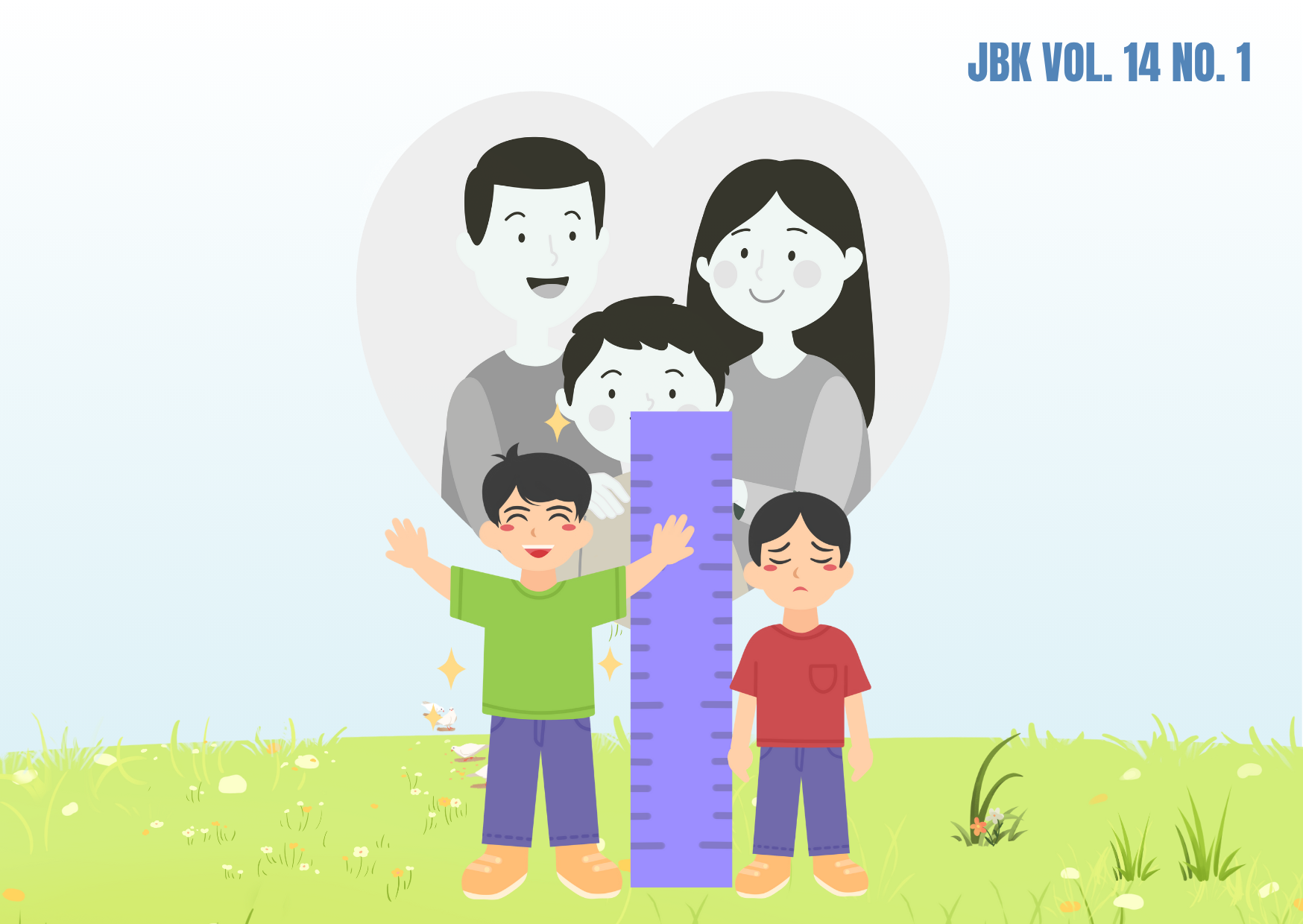K-MEANS CLUSTER ANALYSIS OF SUB-DISTRICTS IN SIDOARJO BASED ON LONG-TERM CONTRACEPTIVE METHOD
Downloads
Aina, N., 2018. Analisis Faktor yang Memengaruhi Kebutuhan Ber-KB dengan Pendekatan Social Cognitive Theory. Jurnal Biometrika dan Kependudukan, 7(1), pp.1–10.
Azizah, E.W., Sudarti and Kusuma, H., 2018. Pengaruh Pendidikan, Pendapatan Perkapita dan Jumlah Penduduk terhadap Kemiskinan di Provinsi Jawa Timur. Jurnal Ilmu Ekonomi, 2(1), pp.167–180.
Bachtiyar, N.A. and Wibawani, S., 2017. Implementasi Program Kampung Keluarga Berencana di Dusun Ambeng-Ambeng Desa Ngingas Kecamatan Waru Kabupaten Sidoarjo. Jurnal Dinamika Governance, 7(1), pp.13–26.
Central Bureau of Statistics, 2012. Penduduk Indonesia Menurut Provinsi 1971, 1980, 1990, 1995, 2000 dan 2010. [online] Available at: <https://www.bps.go.id/statictable/2009/02/20/1267/penduduk-indonesia-menurut-provinsi-1971-1980-1990-1995-2000-dan-2010.html>.
Central Bureau of Statistics, 2017. Laju Pertumbuhan Penduduk menurut Provinsi. [online] Available at: <https://www.bps.go.id/statictable/2009/02/20/1268/laju-pertumbuhan-penduduk-menurut-provinsi.html>.
Cahyati, E.D., Herawatie, D. and Wuryanto, E., 2017. Implementasi K-Means Clustering untuk Pemetaan Desa dan Kelurahan di Kabupaten Bangkalan Berdasarkan Contraceptive Prevalence Rate dan Tingkat Pendidikan. Seminar Nasional Matematika dan Aplikasinya, pp.341–348.
Diro, A., Arsiyah and Mahbub, Z., 2014. Implementasi Kebijakan Pengendalian Pertumbuhan Penduduk di Kabupaten Sidoarjo. Jurnal Kebijakan dan Manajemen Publik (JKMP), 2(1), pp.15–28.
Idris, H., 2019. Factors Affecting the Use of Contraceptive in Indonesia: Analysis from the National Socioeconomic Survey (Susenas). KEMAS: Jurnal Kesehatan Masyarakat, 15(1), pp.117–123.
Ihsani, T., Wuryaningsih, C.E. and Sukarno, 2019. Peran Pengambilan Keputusan Penggunaan MKJP di Indonesia (Analisis Lanjut Data SRPJMN Tahun 2017). Jurnal Keluarga Berencana, 4(2), pp.11–19.
Indahwati, L., Wati, L.R. and Wulandari, D.T., 2017. Usia dan Pengalaman KB Berhubungan dengan Pemilihan Metode Kontrasepsi. Journal of Issues in Midwifery, 1(2549–6581), pp.1–18.
Indonesian Ministry of Health, 2013. Kesehatan Reproduksi dan Keluarga Berencana. Buletin Jendela Data dan Informasi Kesehatan, 2(2).
Indonesian Ministry of Health, 2014. Pedoman Manajemen Pelayanan Keluarga Berencana. Revisi ed. Jakarta: Indonesian Ministry of Health.
Kaniki, F., 2019. Factors Influencing the Use of Modern Contraceptive Methods among Rural Women of Child Bearing Age in the Democratic Republic of the Congo. Journal of Family Medicine and Primary Care, 8(8), pp.2582–2586.
Khoirunnisa, S. and Dzikkrullah, A.A., 2020. Pengelompokan Kecamatan Berdasarkan Alat Kontrasepsi KB Aktif dengan Metode K-Means di DIY. Seminar Nasional Matematika dan Pendidikan Matematika (Sendika), 6(1), pp.104–109.
Kuntoro, 2011. Metode Statistik. Revisi ed. Surabaya: Melati.
Najihah, D., 2017. Resistensi Masyarakat Terhadap Program Keluarga Berencana (KB) (Studi di Desa Penambangan Kecamatan Balongbendo Sidoarjo). Thesis. Universitas Muhammadiyah Malang.
National Board of Population and Family Planning and Central Bureau of Statistics, 2019. Survei Kinerja dan Akuntabilitas Program KKBPK (SKAP) Keluarga. Jakarta.
National Board of Population and Family Planning, Central Bureau of Statistics, Indonesian Ministry of Health and USAID, 2018. Survei Demografi Kesehatan Indonesia 2017. Jakarta.
Nugroho, D.Y. and Wibowo, A., 2019. Analisis Cluster K-Means Kabupaten/Kota di Jawa Timur Berdasarkan Level Epidemik HIV. Jurnal Biometrika dan Kependudukan, 8(2), pp.109–119.
Öztürk Ä°nal, Z., Ä°nal, H.A., Küçükkendirci, H., Sargın Oruç, A. and Günenç, O., 2017. The Level of using Family Planning Methods and Factors that Influence the Preference of Methods in The Konya-Meram Area. Journal of the Turkish German Gynecological Association, 18(2), pp.72–76.
Parsian, M., 2015. Data Algorithms: Recipes for Scaling Up with Hadoop and Spark. USA: O'Reilly Media.
Peterson, E.W.F., 2017. The Role of Population in Economic Growth. SAGE Open, 7(4), pp.1–15.
Restiani, I.D., 2016. Pengelompokkan Kabupaten/Kota di Provinsi Jawa Timur Berdasarkan Peserta KB. Thesis. Institut Teknologi Sepuluh November.
Septalia, R. and Puspitasari, N., 2017. Faktor yang Memengaruhi Pemilihan Metode Kontrasepsi. Jurnal Biometrika dan Kependudukan, 5(2), pp.91–98.
Setyowati, E., Arsiyah and Balahmar, A.R., 2016. Peran Petugas Lapangan Keluarga Berencana dan Pembantu Pembina Keluarga Berencana Desa dalam Mensosialisasikan Alat Kontrasepsi. Jurnal Kebijakan dan Manajemen Publik (JKMP), 4(2), pp.169–182.
Silvi, R., 2018. Analisis Cluster dengan Data Outlier Menggunakan Centroid Linkage dan KMeans Clustering untuk Pengelompokkan Indikator HIV/AIDS di Indonesia. Jurnal Matematika "MANTIK”, 4(1), pp.22–31.
Sumartini and Indriani, D., 2017. Pengaruh Keinginan Pasangan Usia Subur (Pus) dalam Penggunaan Metode Kontrasepsi Jangka Panjang. Jurnal Biometrika dan Kependudukan, 5(1), pp.27–34.
Triyanto, L. and Indriani, D., 2018. Faktor yang Memengaruhi Penggunaan Jenis Metode Kontrasepsi Jangka Panjang (MKJP) pada Wanita Menikah Usia Subur di Provinsi Jawa Timur. The Indonesian Journal of Public Health, 13(2), pp.244–255.
Wati, D.A.M., Puspitasari, D. and Purwaningsih, E., 2019. Metode Clustering pada Model Algoritma K-Means untuk Pemilihan Alat Kontrasepsi. Informatics for Educators and Professionals, 3(2), pp.129–138.
Yulianti, I.F., 2018. Segmentasi Provinsi Berdasarkan Indikator Kinerja Utama Program KKBPK Menggunakan K-Means Cluster. In: Prosiding Seminar Nasional Statistika, Departemen Statistika, FMIPA Universitas Padjadjaran, 7(1).
Copyright©2022 Jurnal Biometrika dan Kependudukan (Journal of Biometrics and Population)
This work is licensed under a Creative Commons Attribution-NonCommercial-ShareAlike 4.0 International License.
1. Copyright of all journal manuscripts is held by the Jurnal Biometrika dan Kependudukan.
2. Formal legal provisions to access digital articles of the electronic journals are subject to the provision of the Creative Commons Attribution-ShareAlike license (CC BY-NC-SA), which means that Jurnal Kesehatan Biometrika dan Kependudukan to keep, transfer media/format, manage in the form of databases, maintain, and publish articles.
3. Published manuscripts both printed and electronic are open access for educational, research, and library purposes. Additionally, the editorial board is not responsible for any violations of copyright law.



































